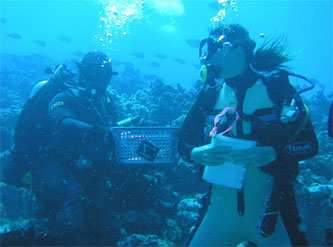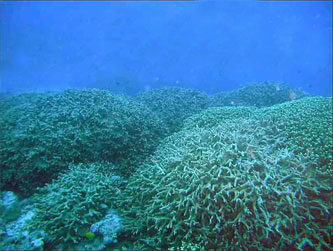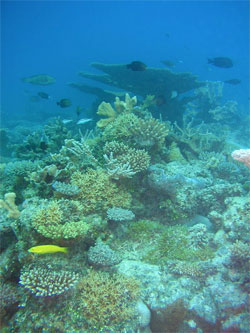50 years after the blast: Recovery in Bikini Atoll’s coral reef
50 years after the blast: Recovery in Bikini Atoll’s coral reef
Amber Dance, special to mongabay.com
May 27, 2008
|
|
Fifty years after atomic bombs rocked Bikini Atoll and pulverized its coral reef, the lagoon again boasts a flourishing coral community.
Scientists diving in the two-kilometer-wide Bravo Crater, created in 1954 by a blast 1,000 times stronger than the bomb dropped on Hiroshima, Japan, found a thriving habitat with treelike corals 30 centimeters (one foot) thick. The study shows that coral reefs can recover from profound damage—when humans leave them alone.
The Marshall Islands, in the central Pacific Ocean, hosted 23 U.S. nuclear tests in the 1940s and ’50s. The current study, published in the March issue of Marine Pollution Bulletin, is the first to examine coral diversity at Bikini since 1954, before the Bravo bomb vaporized three islands and left the 73-meter (240 feet) deep crater.
 Zoe is helped immensely in the field by local Bikinese “Eddie”, photo by Silvia Pinca |
The scientists found that about 70 percent of the atoll’s previous coral species have resettled the lagoon. “It’s made a brilliant recovery at Bikini Atoll,” said biologist Zoe Richards, a graduate student at the James Cook University in Australia and one of the study’s authors. However, the team found no signs of 28 delicate corals that used to live at Bikini.
When she slid into the water to collect specimens in 2002, Richards wasn’t sure what she would find—a moonscape, perhaps, or grotesque mutated creatures. While she did observe some barren sites, others were populated by masses of healthy-looking corals in yellow, brown, and red. She brought the specimens back to Australia for identification, a lengthy process, and compared the current species with the 1954 survey.
An explosive history
 Lagoonal coral reef habitat at Bikini, photo by Silvia Pinca |
The Bikini natives evacuated the atoll in 1946 to free it for nuclear testing. Above the water, the land is still strewn with cement blocks, the remains of bunkers and bridges built by the military. While visiting the atoll poses no threat to human health, the soil is contaminated. Plants soak up cesium-137 and other dangerous isotopes; the atoll is strewn with radioactive coconuts, and Bikini produce is unsafe to eat. The Bikini people, now scattered across the Marshall Islands, hope to decontaminate the ground and eventually return to their homeland.
Richards compared the Bravo bomb’s impact to 50 hurricanes striking all at once. The water flash-boiled as temperatures soared to 55,000 degrees Celsius (100,000 degrees Fahrenheit), and chunks of coral hit military boats in the lagoon as 30-meter (100 foot) waves sped outward. The blast stirred up millions of tons of sand that blocked sunlight and smothered the remaining corals when it resettled on the ocean floor.
Little was known about Bikini’s corals after the bombing until the local government invited scientists to examine the lagoon.
“Knowing about the history of Bikini, it was just begging for exploration,” Richards said. She dove at 19 sites around the atoll to compile her survey.
Time to heal
 Porites matrices growing in the Bravo Crater, photo by Silvia Pinca |
Coral’s ability to release free-floating larvae likely contributed to Bikini’s recovery. Coral are small animals that live together with algae. The algae turn sunlight into the energy to build the reefs. Corals can replicate in one place by simple fission, or reproduce sexually by releasing eggs and sperm. The eggs and sperm fuse to form larvae that drift with the current.
Richards suspects the Bikini lagoon was reseeded with coral larvae from the Rongalap Atoll, about 100 kilometers (60 miles) upstream on prevailing Pacific currents. Of the species she couldn’t find, many were delicate, soft-sediment corals that would have been easily uprooted. Several of these species rarely use sexual reproduction, so few larvae would be expected to travel from Rongalap.
“This paper gives some encouragement that there’s some resilience in the system,” said Terry Done, a retired coral reef ecologist who was not involved in the study.
However, the study authors are quick to caution that Bikini Atoll was a special case. Ironically, the radiation that made the land uninhabitable protected the reef from human interference, providing the necessary recovery time. Bikini also had the advantage of nearby Rongalap’s reef as a source of replenishment.
Other reefs may not be so lucky. Coral reefs today face a number of challenges, from invasive starfish and the prying fingers of divers to pollution and global climate change. These stresses can cause the corals to evict the algae they rely on for energy production and sun protection. The sunlight bleaches the corals stark white. If the stressful conditions continue, they will die. Other studies have warned that many of the world’s reefs could vanish within decades.
“The reefs need to be looked after in between these catastrophic events,” Done said.
Amber Dance is a graduate student in the Science Communication Program at the University of California, Santa Cruz.